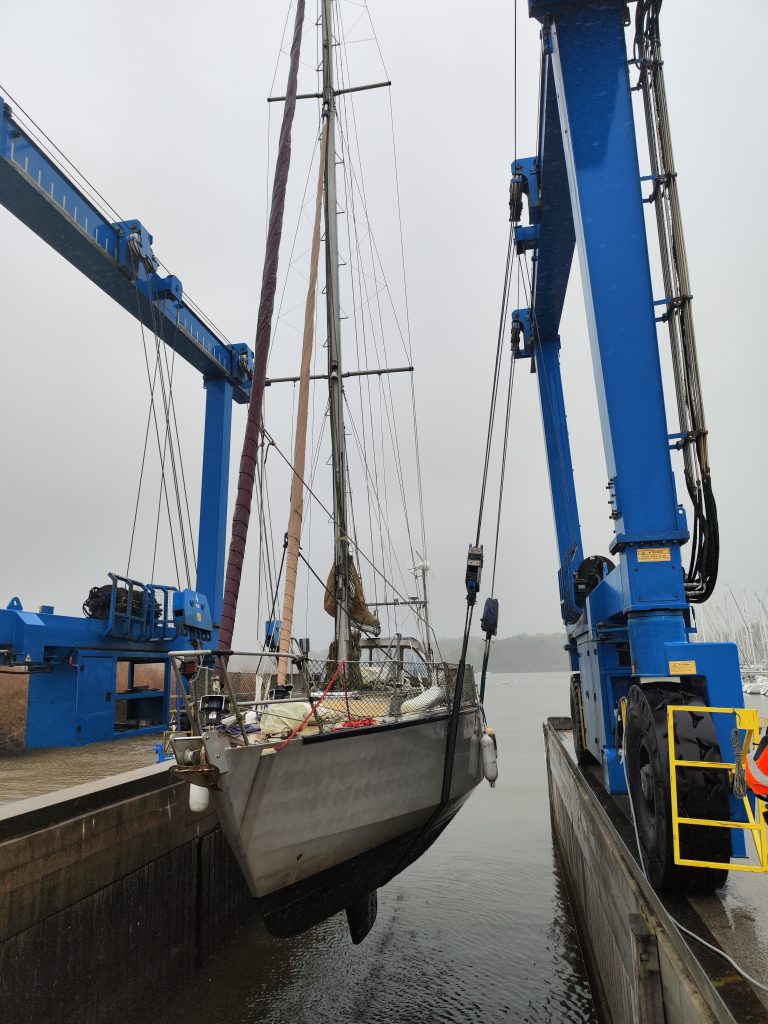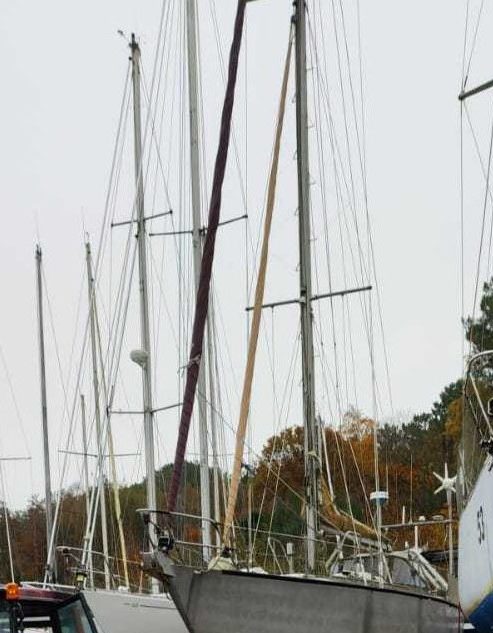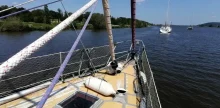November 2023; Vilaine, Brittany France.
The journey begins with a motorway closure. Instead of driving quickly towards Belgium, I’m stuck for 3 hours in a motorway construction site just before Cologne. I actually wanted to spend a cosy night on the way. Unfortunately, that doesn’t work out now. After the traffic jam has cleared, I head west into the wet November night. The north of France is flooded and there are detours to master as well as periods of tiredness. Somehow I manage to get through, grab a coffee from a lost vending machine at a motorway service station and get another good night’s sleep. I have arranged to meet Antoine at 10.00am in the car park of a river marina. Antoine is the owner of a 12m aluminium sailing yacht, which he has offered me to buy after we have been chatting on WhatsApp for a few weeks now. I found the offer on a portal for sailing boats. It’s a 30-year-old, robust boat – a bit scruffy and above all very, very grey.
I started to define my search criteria in summer. In addition to steel, aluminium was at the top of the list of hull materials. My plan has always been to convert a potential new acquisition into a blue-water sailing boat within a manageable refit period, with full personal commitment. Teak on the deck and other seafaring jewellery tend to interfere with my plans due to the necessary demanding care and the unavoidable sensitivity of the materials. Instead of polishing surfaces, I prefer to refurbish and maintain the exciting nautical technology. No, SUN is not a beauty. However, the boat’s state of preservation and its simple robustness have great potential for my requirements.
I meet Antoine – he is already in full sailing gear in the car park. Antoine and I have agreed to spend three days inspecting the boat and drawing up the contract. The plan is to check the interior, the technology and all the accessories and also inspect the hull. Antoine hasn’t had much time to look after his boat since he started a family. The budget was probably also tight. In addintion he lives 700 kilometres further south in France. So he decided to sell.
After clearing out his possessions, there was obviously no time left for cleaning. The yacht spent some time unsailed on a buoy in the river. As southern Brittany is spoilt by the warm Gulf Stream, you don’t have to reckon with drift ice here and so she stayed in the water even during winter. The disadvantage of the whole thing is the algae growth on the running rigging and everywhere where wood has been used on deck, but I don’t let it bother me. This can be quickly removed with a simple cleaner.
The first test trip is then upriver with a good wind – it is possible to set all the sails. As described in the offer, they are relatively old but still in surprisingly good condition. Of the 3 previous owners, only the first had sailed for long periods of time. The others probably used the yacht mainly during their summer holidays.
I take the opportunity to check the rig. The aluminium deck, which is firmly welded to the hull, is very practical. All the deck fittings are bombproof and corrosion-free. The mast and the rigging are in good order. However, the boom has a kink at the attachment point of the downhaul. This damage was not mentioned in the offer and cannot be seen in the pictures. After sailing off, we motor back to the marina and tie up. The good old Perkins 4.108 starts safely and runs without any further problems. The oil pressure is right. It already has 4000 hours on the clock. Supposedly it will last at least that long again with good maintenance.
The open saloon without bulkheads is unusual, but I really like the feeling of open space below deck. There are plenty of niches and lockers for stowage, the large stainless steel diesel and water tanks are professionally installed and securely insulated from the hull material. The large diesel tank in the keel is the only tank made directly from aluminium. The electrical, water and fuel installations look neat and uniform throughout.
In general, time has stood still. The electronics are 100% from the time of the first launch. The radio doesn’t work – I’m not quite sure about the radar, which still uses an electron tube. Many of the navigation electronics displays are faded, and the log was no longer screwed into the hull grommet after the last service. The anemometer on the masthead no longer turns. The high-pressure pump for the watermaker was probably no longer fitted after a earlier service and the only remainder of the shaft generator is a pulley and a lost V-belt still hanging on the reversing gear.
After the first evening, I’m a bit frustrated – whether because of the night I’ve travelled through or the deviations from the original offer, in which the shaft generator, the watermaker and the undamaged rig were listed as functional.
In this area in France, everyone is probably a sailor in some way. My room in a rural B&B near the marina with Patrick and Sylvie is very nautically styled. The two of them sail in a boat club themselves. After I tell them a bit about my frustration and uncertainty, they give me some very good advice. Finally after a very restful sleep in the cosy room, I’m much fitter and more frustration-tolerant after breakfast the next day.
I meet up with Antoine again at the harbour. We now try to get a crane appointment. The local shipyard is closed due to a public holiday and the following bridge day – this was not planned. We are finally lucky in a neighbouring town. A crane job would be available the next day. We spend the whole morning checking the inventory and testing the devices. I check the bilge and the seacocks – everything is very dry and perfect, the hull looks like new on the inside. There is no corrosion. The engine is a little oily – but according to the relevant sailing forums, this is apparently normal for an old Perkins. The oil is collected in a clean aluminium tray and cannot flow into the bilge. The anchor windlass and remote control, the electric autopilot and the massive Danish stove all work well. The large wind pilot is stowed in the stern and is visibly complete, its bracket is firmly bolted to the stern. Unfortunately, there is no time to test it. The dinghy’s outboard engine and the dinghy itself are just one year old. There are still a lot of spare parts in the hollow spaces in the stern, a ladder, a boom brake, a third headsail with associated staysail, a gennaker and so on.
In the afternoon, we negotiate the contract and correct the inventory list. That takes longer than expected. I’ve brought a printer with me so that I can record everything on paper as securely as possible. The contract text comes from a standard contract on the Internet. There was no CE confirmation declaration necessary in the times when the boat was built. (I later found the registration of the declaration of acceptance in the French National Archives, which was drawn up on a national basis in 1983). The biggest discrepancies I found were deducted from the offer price during the negotiation. These are essentially the missing high-pressure pump, the missing shaft generator, the defective radio, the radar, the defective boom and the generally poor overall condition of the electronics. We were finally able to agree on a purchase price – which was then still subject to the hull inspection. As soon as the transfer of the purchase price would have been completed, the SUN is to be deleted from the French ship register (radiation du pavillon francais).

The next day – which was supposed to be the last of the trip – we set sail again. The wind had picked up in the last few hours and so we were able to sail quickly down the river in about 6-7 force winds. On this winterly day we are the only moving sailing vessel on the river. The storm during the night had torn several sailing boats off the mooring buoys and pushed them onto the rocky riverbank. SUN remained completely unimpressed, even when the wind continued to pick up once coming closer to the sea. We were able to sail straight into the crane shaft. After clearing, the boat got caught in the straps. The crane scales showed approx. 9.5 tonnes. The ships propeller made of gunmetal had started to corrode because of a missing anode – we were lucky – after a few weeks, nothing could have been saved. The ring anode on the stainless steel shaft probably fell off very recently. The hull anodes and the anode on the rudder are still reasonably intact.
Due to uneven loading, the yacht does not lie exactly in the waterline as previewn by the design. At the bow, the hull coating is exposed to the air. Behind the antifouling on the narrow strip that was lying dry, the primer has come off and corrosion bubbles have formed. When the last antifouling layer was applied the corrosive parts were just covered and not cared for. Annoyed by the new deviation from the initial boat-offering, I was on the verge of not signing the contract. Fortunately, Antoine found a service technician from the aluminium yard nearby who was able to calm me down a bit. He said that blisters often form in these critical hull areas around the waterline and that they are easily remedied by renewing the primer coating. The corrosion is superficial and only in a limited area. Antoine agreed to have the damage repaired at his expense. Further he mentionned that dangerous corrosion in Aluminum boats usually start from the inside of the hull.
Returned to the marina in the late afternoon after about 2 hours of motoring, the contract was finally signed. I didn’t have a place in the dry storage yet and the only boatyard with spaces didn’t open until the next day. The contract was signed and I had a boat – about 1300 kilometres away from home. Antoine set off. Without further ado, I took another day’s holiday and moved into the SUN.

I was very lucky. The shipyard finally made it possible to drive straight to the slipway in the morning. There were still free berths in the outer store. One-handed on the unfamiliar boat, I set off from the jetty and with two attempts and a good push from the Perkins, I finally hit the slipway trolley. I quickly secured everything, took down the two headsails and headed back home on the motorway as the proud owner of an aluminium sailboat.

